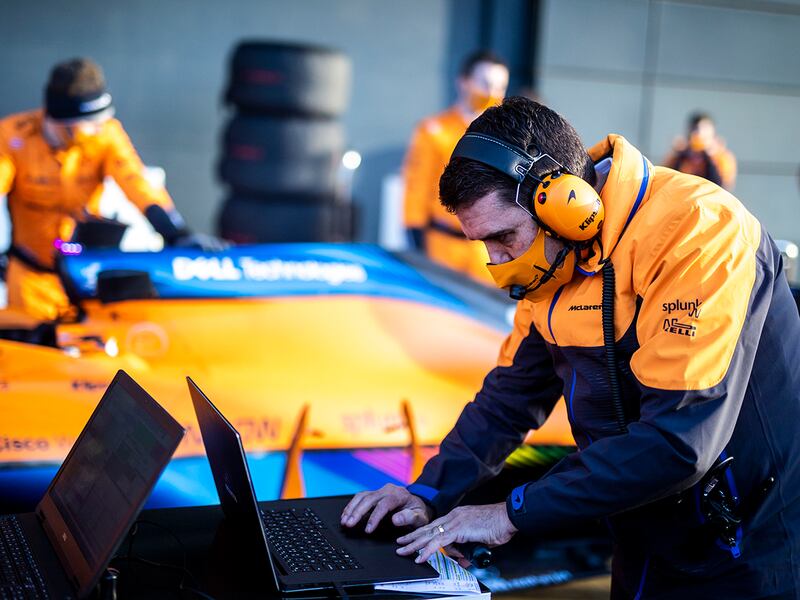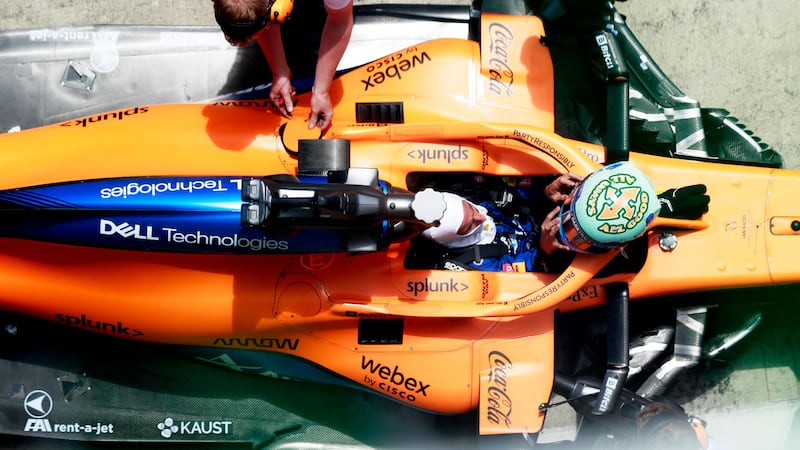The bright orange nose of the car just won’t go quite where I want it to, and now the 1,000-or-so horsepower coming from the engine is shoving the back end of the car wide, tipping me into a high speed spin. Revs wailing skyward, and with a thick fog of smoke coming from the now-spinning rear tyres, I’m now bouncing over the sawtooth kerb at the outer edge of Silverstone’s famed and fearsome Copse corner. To my right is the racetrack I’ve just departed. To my left is a rapidly approaching tyre barrier.
Thankfully, at this point, a helpful hand reaches into the cockpit and presses the reset button. The shaking of the cockpit and steering wheel subsides, and I’m back in the room. The room being the ICC conference centre in Belfast, where the Big Data Belfast 2002 tech festival is being held. I scramble out of the tightfitting plastic seat, and back into a world where I’m a sedentary writer, rather than a snake-hipped, gimlet-eyed racing driver. Ah well, we can all dream.
The F1 race car simulator, set up just outside the main conference stage, has been brought along by McLaren. For anyone with even a vague notion of motor racing, McLaren is a storied name, with multiple F1 race wins and world championships behind it, not to mention victories in the Indianapolis 500, Le Mans, and so many others. Its driver roster is a who’s who of racing greats, from James Hunt and Emmerson Fittipalidi, via Niki Lauda, Ayrton Senna, and Alain Prost, to the team’s two current F1 front-runners, Lando Norris and Daniel Ricciardo.
Norris and Ricciardo will, of course, also be spending their days away from the racetrack plugged into a simulator, but it’s a bit more of a sophisticated simulator than the glorified video game I’ve just been playing. “We’ve got this digital twin of our F1 car, which exists in the world of computer fluid dynamics. We analyse every single cubic centimetre of air that passes over the car, virtually, and that’s what feeds into our simulator model,” says Edward Green, McLaren’s head of commercial technology and one of the team’s leading IT lights.
READ MORE
He’s in town to help promote McLaren’s partnership with Dell Technologies, but I’m of course keen to press him for more details on the actual racing. And the virtual racing, such as how the team’s full-on, immersive simulator manages to copy the sorts of g-forces that the drivers experience on track. At which point, Green goes atypically quiet. “I can’t talk about that …” he says, smiling slightly at the inferred secret.
Thankfully, Green can talk about other things, such as how F1 is increasingly a war of software. Back in the 1990s and early 2000s, most F1 experimentation was empirical — the teams had whole separate organisations that filled the weekends between races with endless testing, shipping spare cars and spare drivers to racetracks around the world. New parts would be designed and manufactured, bolted on to the test car, and if it went faster with them, then copies of that part would be dispatched to the race team, helping to find those finely-sliced fractions of seconds of laptime.
These days, that’s not allowed. In an effort to reign-in spiralling costs, Formula One has introduced a cost cap, limiting teams to a $145-million (€135m) operating budget for each season (not counting engine costs and driver salaries). Testing has been reduced from every other day, to just three or four days a year. So software has stepped forward to help fill that gap.

“I think as an IT person, I’d love to say that Formula One is now a software formula,” says Green. “What it really is, is multidisciplinary, which is exciting to see. So if you look at the strategy of each race, we run 300-million simulations of each race, so that the guys on the pitwall have — from second to second — the best possible advice on what to do in a given situation. You know, you might get three seconds to decide, as the safety car is coming out, whether or not to bring your car into the pits for a tyre change. So in three seconds you’ve got to decide, communicate with the driver, get the pit crew out and ready — it’s really hard to do that, so we use AI and neural networks from Dell to give the team the best possible set of options.”
While there are, obviously, experts in vehicle performance, engine capability, and tyres sitting in mission control, for the race day McLaren also gets its HQ staff — from postroom staff to IT engineers — are encouraged to strap on a set of headphones and get involved, including listening to rival teams’ radio communications for strategic hints.
Even the room itself plays a part — it’s filled with LED lights that pulse yellow in the case of a danger warning on the track; red if the race is stopped; and green for a restart. The Dell tech is put to good use, by ensuring there’s a minimal delay — as little as 35-milliseconds — between something happening on track, and it being recorded in mission control.
It goes further. After each race, the McLaren IT squad will play back the entire event, rerunning it both from their own point of view, but also ‘playing’ each race as one of their competitors, looking at strategies made and missed, and trying to see where in the decision loop extra time, or extra advantage can be found.
It’s not just about the team at the trackside, either. Ultimately, winning or losing a race comes down to the driver, the pit-crew, and the team manager (Andreas Seidl, a former head of Porsche’s Le Mans efforts) at the event, but giving all of them maximum backup is a ‘mission control’ back at the team’s HQ in Woking just outside London.
“It works just like the mission control you see in Apollo 13, just these days with fewer waistcoats and cigars,” Green tells The Irish Times. “As an environment, it’s very calm, so it can be better from a decision making point of view. Everything that we use trackside, in an IT sense, is replicated back at base and then some, because obviously we have more capacity to do so.”
The Dell computing ‘rig’ that McLaren takes to each race consists of six chassis, with 4.5-terabytes of memory, and 140-terabytes of local storage. There are 72 processors and the system runs through about 12-terabytes of data each weekend. Each car, on its own, creates about 1.5-terabytes of data each weekend, fed by numerous sensors — so numerous that they actually remove some from the car for the race itself, as there’s a weight penalty. When actually in the heat of competition. priority is given to systems that dictate winning or losing — tyres, fuel, engine, aero loads and so on. Everything else is recorded for later downloading and dissection.
Of course, there are more pedestrian concerns to be addressed. Green says that when Dell originally came on board as a partner, its first task was to update McLaren’s staff IT systems, improving things such as issuing laptops that were already loaded up with software and data, rather than having staff waiting around to get their new computers switched on properly. Next week, he’s working on a project to analyse the all-important data from the McLaren factory’s coffee machines, ensuring that hard-working designers and mechanics can get a cappuccino when they need one. It sounds trivial, but for want of a shoe a horse was lost, and all that.

What happens when it all goes wrong, though, as it inevitably will? McLaren has had its performance doldrums lately, and while the team is working its way back to the front — winning the Italian Grand Prix last year — it’s also still prone to an off-weekend. How does software help? “It’s about what we can do in the back end to make the transfer of data faster and easier,” says Green.
“It’s about the culture of the team, recognising that performance can change, but not to let your head go down when that happens. From my perspective, it’s about making sure that we’ve got the capacity to build the software platforms so that the team can come up with new ideas. Maybe we need to open up some more software capacity for the aerodynamics team to do more computational fluid dynamics runs, or maybe we need more resources for strategy and simulation.”
All that effort is worth it when the team gets weekends like Italy last year. “I’d had somebody that joined my team the week before and I had to sort of explain to them that Mondays in the office are not normally like this” says Green. “I think it’s really important to celebrate them, and then get back to work. It’s awesome to see those kind of performances come off on track. I couldn’t quite believe it, and it took a while for it to sink in. But you know, celebrate them as a team. Enjoy those moments and then get back to it.”
He might be a software engineer, but Green speaks like a pure racer.














